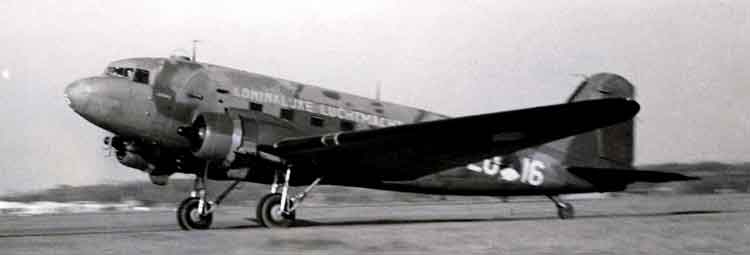
|
||
|
Visiting Dutch Douglas C-47 Dakota Anglo-German Open Day - 19Jun57. (Thanks to John Hill.) Douglas DC-3 and C-47 Skytrain/Dakota Originally designed to one particular airline's specification, the DC-3 was to become the most important transport aircraft of World War II and the means by which normal communications, supplies and stability were restored to many areas of the world at the war's end. It then provided the backbone for early post-war civilian passenger and freight services, roles in which hundreds of examples still continue. In 1934 American Airlines asked Douglas to enlarge and improve the DC-2 airliner in order to provide an overnight/sleeper airliner for its domestic trans-continental services. This resulted in the DST (Douglas Sleeper Transport) design with 14 berths, first flown on 17Dec35. The DST design was itself varied as the daytime DC-3, a 21-28 seat airliner which American Airlines used when it entered service on 25Jun36. The early production DSTs were powered by Wright Cyclone piston engines, but later DSTs utilised the specified Twin Wasps. This was similarly the case with early DC-3s (the DC-3A and most DC-3B day/night cabin convertible models used the Twin Wasp). The DC-3 low-wing, tail-wheeled, all-metal construction monoplane raised the reliability, standards and economics of commercial air travel to new levels. Its ubiquity contributed to a growth in airline networks - over 430 had been delivered to airlines worldwide by late 1941. The United States's entry into World War II brought with it the need for a utility transport aircraft capable of operating in any theatre. The DC-3 fitted the bill and it was available off-the-shelf. Many existing DC-3A were impressed into military service, but they were joined by over 10,000 examples built for the military and designated C-47 Skytrain (or Dakota in Britain) - in the region of 9,000 being powered by the Twin Wasp engine. Additionally, a further 2,000 examples were built in the Soviet Union under the designation Lisunov Li-2. Hundreds more derivatives were built by Japan under the auspices of Mitsui. The C-47 flew in every theatre of operations. Roles included dropping paratroopers, glider towing, air supply and cargo lifts, often conducted in the most inhospitable combat, geographic and climate conditions. Many thousands of the rugged DC-3s survived these experiences and were the obvious choice to undergo rapid conversion programmes in order to plug the gap in availability of commercial transports when hostilities ended in 1945. Although major airlines moved on to newer airliners within a few years, the DC-3 became extremely popular with independent airlines operating short-haul passenger services, and remained so well into the 1970s. The C-47 was no less popular with post-war militaries including the US, which operated an extraordinary range of sub-types including the AC-47 gunship conversion used in the Vietnam War. Hundreds of DC-3s remain in service today, mostly with civilian operators as freighters or pollution/bug sprayers. Passenger/combi versions remain operable with South America and there are a number engaged on passenger work associated with nostalgic/leisure trips in the northern hemisphere, sometimes run by preservation or enthusiast groups. Specifications apply to the DC-3A. Crew: 5; Powerplant: two 746 KW (1,000 hp) Wright R-1820-53 Cyclone 9-cylinder radial engines; Performance: max speed 346 Km/h (215 mph); range 1,931 Km (1,200 miles) service ceiling 7,285 m (23,900 ft) Dimensions: wingspan 27.28 m(89 ft 6 in); length 17.63 m (57 ft 10 in); height 4.62 m (15 ft 2 in). Weight: 12,552Kg (27,673 lb) loaded. Armament: one 7.62 mm (0.30 in) machine gun in nose, dorsal and ventral positions; up to 2,948 Kg (6,500 lb) of bombs. (Thanks to The Encyclopedia of Aircraft edited by Robert Jackson). |
||